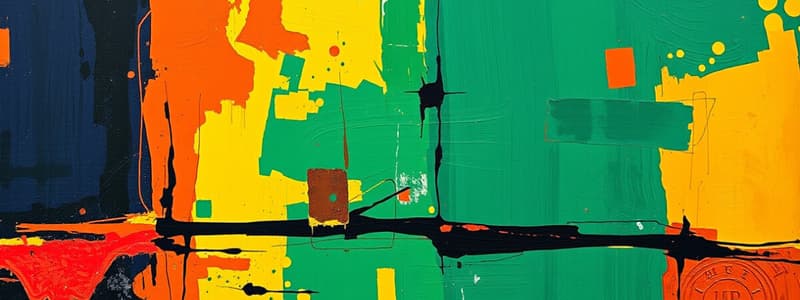Podcast
Questions and Answers
What does the phrase 'broken images' symbolize in the context of the poem?
What does the phrase 'broken images' symbolize in the context of the poem?
'Broken images' symbolize a fragmented and damaged world that has failed to protect innocent lives.
How does Boland's use of language shift throughout the poem?
How does Boland's use of language shift throughout the poem?
Boland shifts from euphemistic language to direct, blunt expressions, emphasizing the gravity of the child's fate and our failures.
What is implied by the line 'our times have robbed your cradle'?
What is implied by the line 'our times have robbed your cradle'?
This line implies that the current societal conditions and acts of violence have stripped the child of a safe, nurturing environment.
What is the overall urgency expressed in the final stanza of the poem?
What is the overall urgency expressed in the final stanza of the poem?
Flashcards are hidden until you start studying
Study Notes
Overview of 'Child of Our Time'
- Written on May 17, 1974, amid The Troubles in Ireland.
- Inspired by a photograph of a fireman rescuing a child after the Dublin and Monaghan car bombings, which resulted in 34 deaths, including infants.
- Dedicated to Aengus, a child who died from ‘cot death,’ enhancing the poem’s personal quality.
Structure and Form
- Comprises three stanzas, each a sestet (six lines), presenting itself as a lament or elegy.
- Mournful tone conveys grief and urgency for societal change.
- Uses a mix of full and slant rhyme to create a discordant auditory experience, reflecting chaos and violence.
Title Significance
- The word ‘child’ symbolizes innocence and connects to familial bonds.
- ‘Of Our Time’ extends the claim of this child’s experience to society as a whole, emphasizing collective responsibility.
Key Ideas
- Highlights the innocence of children amidst societal violence.
- Critiques societal neglect and unnatural death.
- Advocates for social responsibility and condemnation of societal failures.
Stylistic Elements
- Precise language creates evocative imagery relating to childhood and music.
- Repetition through techniques like anadiplosis and anaphora enhances emotional resonance.
- Employs evocative alliteration generating rhythmic quality.
Stanza Analysis
-
First Stanza:
- Personal reflection on the loss, emphasizes the abrupt need for lullabies due to senseless death.
- Contrasts tenderness with the harsh realities of violence, using strong imagery linked to the child’s death.
-
Second Stanza:
- Shifts from personal to collective ‘we,’ highlighting societal failure in protecting children.
- Through the imagery of comforting tales and rhythms, Boland illustrates the innocence lost and the failure of adults to safeguard it.
- Language serves as a pivotal theme, emphasizing the disconnect in communication and the necessity of learning from loss.
-
Third Stanza:
- Urgency to rebuild from ‘broken images’ symbolizes a fragmented society.
- Calls for accountability, urging society to establish a new language to prevent future tragedies.
- Final line offers a hopeful notion of peace for the lost child, juxtaposing the world’s violence with a desire for safety.
Overall Themes and Messages
- A profound critique of societal complacency and violence, advocating for change and accountability.
- The child’s death serves as a catalyst prompting reflection on collective responsibility towards innocent lives.
- The emotional depth calls for a re-evaluation of how society nurtures and protects its most vulnerable members.
Studying That Suits You
Use AI to generate personalized quizzes and flashcards to suit your learning preferences.





